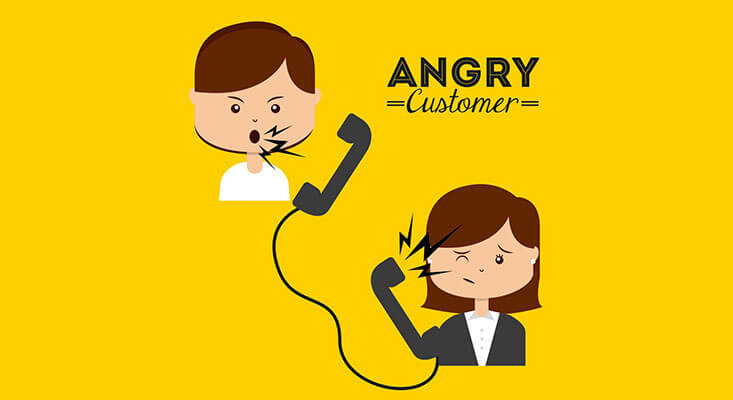
Do you know how to keep your customers satisfied?
Customer service is a high-stakes game. Every company is competing for the same customers, and customer satisfaction is one of the main differentiators between success and failure.
Perhaps one of the greatest risks to company reputation today is that a single disgruntled customer has the power to disrupt your whole operation with the power of social media, which can amplify their complaints across the web.
For this reason, customer experience has become the key to business success.
Worried?
Don’t be.
We’ve compiled a list of 105 customer service statistics and trends to help you provide delightful support experience.
- Latest Customer Experience Trends
- What Customers Think of CX
- Customers Communication Statistics
- Poor Customer Service Experiences
- How Personal Touch Empowers Businesses
- Great Customer Service Statistics
- Building Brand Loyalty
- Millennials Today
- Customer Service Stats for Social Media
- Rise of the Automation Industry & Self-Service
Build a Delightful Customer Experience With These Customer Service Statistics
Access to trends and insights on customer experience is important for your brand to learn about the areas where you can improve your services and products. With this blog, we aim to help you do just that. Let’s take a look at the stats below.
Latest Customer Experience Trends

1. A customer experience promoter has a lifetime value to a company that’s 600 to 1,400% that of a detractor. – BainTweet this
2. 46% of decision-makers in global contact centers expect their business to grow 5-10% in the next year, while 14% project a massive growth of more than 10%. – ForresterTweet this
3. Around 54% of all consumers globally say they have higher customer service expectations than they did just one year ago. – MicrosoftTweet this
4. Worldwide, 67% of people believe that customer service as a whole is improving. – MicrosoftTweet this
5. In 2017, 64% of customers in the United States connected with some form of customer service. – StatistaTweet this
6. 56% of people around the globe believe that companies need to take action on feedback provided by their customers. – MicrosoftTweet this
7. 81% of Americans report that businesses are either meeting or exceeding expectations when it comes to customer service. – American ExpressTweet this
8. 40% of all Americans believe that businesses have begun to better focus their attention on customer service. – American ExpressTweet this
9. 75% of brands report that they are measuring customer engagement, but cannot define what it is. – KolskyTweet this
10. 60% of customer service teams deliver support across three or more channels. – HiverTweet this
Takeaway: Customers today have higher expectations from brands. Due to this, we see many brands working day and night to improve customer experience with an intent to exceed their expectations with their services.
What Customers Think of CX

10. When it comes to making a purchase, 64% of people find customer experience more important than price. – GartnerTweet this
11. The majority (66%) of adults feel that valuing their time is the most important thing a company can do to provide them with good online customer experience. – ForresterTweet this
12. B2B decision makers felt the lack of speed in interactions with their suppliers is the number one pain point, mentioning twice as often as price. – Temkin GroupTweet this
13. Feeling unappreciated is the #1 reason customers switch away from products and services. – NewVoiceMediaTweet this
Takeaway: Customers give more importance to the services and are ready to pay more for quality. They wish to avoid lack of speed when it comes to support interactions because it makes them feel unappreciated.
Customers Communication Statistics

14. Out of all customer service engagements around the world in 2017, 52% began online. – MicrosoftTweet this
15. 67% of customer service interactions can be handled by a dedicated community of core customers. – KolskyTweet this
16. 90% of consumers expect an online portal for customer service. – MicrosoftTweet this
17. 88% of consumers are influenced by online customer service reviews when making a buying decision. – Dimensional SearchTweet this
18. 68% of consumers say that a brand’s perception becomes positive when companies send proactive customer service notifications to them. – MicrosoftTweet this
19. 86% of millennials say they are influenced by negative reviews when purchasing a product or service. – Dimensional ResearchTweet this
20. 23% of consumers seek face-to-face interactions for complicated customer service issues like troubleshooting. – American ExpressTweet this
21. 57% of customers would rather contact companies via digital media such as email than use voice-based customer support. – AmeyoTweet this
22. For more complicated interactions, such as payment disputes, 40% of customers prefer talking to a real person over the phone. – American ExpressTweet this
23. 74% of Americans have used the landline to contact customer service. – MicrosoftTweet this
24. Globally, only 5% of customer service interactions begin with a face-to-face meeting.Tweet this
25. 79% among millennials are more inclined to buy from brands that have a mobile-responsive customer support portal. – MicrosoftTweet this
26. Nearly 1/3 of customers report sending an SMS/text message to the company requesting assistance. – ForresterTweet this
27. One-third of all customers use their mobile device to initiate contact with customer service. – MicrosoftTweet this
28. 29% of global companies prefer smartphones and mobile devices to traditional computers due to mobility. – KolskyTweet this
29. 66% of consumers have used at least 3 different communication channels to contact customer service. – MicrosoftTweet this
30. 33% of customers have contacted a company through Facebook or similar social channels. – Forrester
Takeaway: Customers instant engagement with a brand and expect the organization to provide online support to help them find answers fast. What’s more, they tend to give more preference to companies who have a mobile-responsive customer support portal and provide help through more than 3 different communication channels.
Poor Customer Service Experiences

31. 4 out of 10 consumers will recommend others not to buy from a business if they have had poor customer service with them. – Dimensional ResearchTweet this
32. Even though fewer customers may be experiencing problems, more customers are inclined to complain about customer service problems than ever before. – DeloitteTweet this
33. 44% of consumers say they received the wrong answer from a customer service representative in the past. – KolskyTweet this
34. 72% of consumers consider it poor customer service if they had to explain their problem to multiple people. – Dimensional ResearchTweet this
35. 47% of consumers have made the choice to switch to a different brand due to bad customer service within the last year. – MicrosoftTweet this
36. After a bad customer service experience, 39% of customers will avoid a company for two years. – Dimensional ResearchTweet this
37. 91% of customers who are unhappy with a brand will just leave without complaining.
– KolskyTweet this
38. 79% of consumers who shared complaints about poor customer experience online had their complaints ignored. – Harris Interactive
39. 56% of people around the world have stopped doing business with a company because of poor customer service experience. – MicrosoftTweet this
40. One-third of consumers say they would consider switching companies after just one instance of bad customer service. – American ExpressTweet this
41. The majority of Americans have decided to not go through with a purchase because of a poor customer service experience. – American ExpressTweet this
42. 67% of customer churn is preventable if firms resolve issues the first time they occur.
– AmeyoTweet this
43. An average American tells 15 people when they’ve had a poor customer service experience. – American ExpressTweet this
44. Men tell more people (21 people) when they experience poor customer service. – American ExpressTweet this
45. On average, women tell about 10 people when they have had a poor customer service experience. – American ExpressTweet this
46. 12% of Americans rate their number one frustration with customer service as “lack of speed.” – StatistaTweet this
47. 27% of Americans report “lack of effectiveness” as their number one frustration with customer service. – StatistaTweet this
Takeaway: Poor brand reputation is a result of bad customer service. And to stop customers leaving without letting the brand know, it is important to work upon their feedback. This can curb negative reviews that customers tend to share and retain them effectively.
How Personal Touch Empowers Businesses

48. 68% of customers said that a pleasant representative was key to their recent positive service experiences. – American ExpressTweet this
49. 75% of customers believe it takes too long to reach a live agent. – Harris InteractiveTweet this
50. 69% of online adults in the US shop more with retailers that offer consistent customer service both online and offline. – ForresterTweet this
51. When Donors Choose sent handwritten thank-you notes to half of all recent first-time donors, 38% of people who received a thank-you note were more likely to give again than those who didn’t receive one. – DonorsChooseTweet this
Takeaway: It is important for brands to add a personal human touch during a support conversation, no matter what medium they choose to interact with customers. Doing so will give the customers the impression that brands care for them.
Great Customer Service Statistics

52. Globally, companies respond to 85% of customer service questions. –
MicrosoftTweet this
53. Friendly customer service representatives, who create a memorable experience, encourage 73% of customers to stick with a brand. – Harris InteractiveTweet this
54. 90% of customers are influenced by positive reviews when buying a product. – Dimensional ResearchTweet this
55. Positive reviews of customer service online are read 6% more than negative ones. – Dimensional ResearchTweet this
56. 52% of consumers say they have made an additional purchase from a company after a positive customer service experience. – Dimensional ResearchTweet this
57. Service insight and knowledge is also key to a good experience according to 62% of consumers. – American ExpressTweet this
58. 68% of customers believe a polite customer service representative is the key to great customer service. – American ExpressTweet this
59. 70% of consumers say they have already made a choice to support a company that delivers great customer service. – American ExpressTweet this
60. About one in three people (30%) say the most important aspect of customer service is speaking with a knowledgeable and friendly agent. – MicrosoftTweet this
61. Attracting a new customer is 6-7 times more expensive than retaining a current one.– KolskyTweet this
62. A 5% increase in customer retention can produce 25% more profit. – BainTweet this
63. Increasing customer retention rates by 5% boost profits by 25% to 95%. – Harvard Business ReviewTweet this
64. Companies that excel in customer experience drive revenues 4% to 8% higher than their peers. – BainTweet this
65. 79% of businesses prefer to use live chat at their website instead of email (61%), phone (44%), and social media (48%) platforms to communicate with customers for instant support. – Econsultancy
Takeaway: Organizations can only receive support from customers if they ensure to provide consistent good customer service. For that they need to hire friendly and knowledgeable agents who are ready to offer anytime, anywhere support. This approach will help to make sure that customers are delighted with the services received by the brand.
Building Brand Loyalty

66. Across the globe, 96% of consumers say customer service is an important factor in their choice of loyalty to a brand. – MicrosoftTweet this
67. 72% of consumers say that when contacting customer service they expect the agent to “know who they are, what they have purchased and had insights into their previous engagements.” – Microsoft Tweet this
68. 67% of customers worldwide say that customer engagement levels have improved in the last 2 years. – AmeyoTweet this
69. 89% of consumers have switched to doing business with a competitor following a poor customer experience. – Harris InteractiveTweet this
70. 33% of customers who abandoned a business relationship last year did so because personalization was lacking. – AccentureTweet this
71. 48% of consumers expect specialized treatment for being a good customer. – AccentureTweet this
72. Brands are viewed more favorably by 77% of consumers if they proactively invite and accept customer feedback. – MicrosoftTweet this
73. When asking consumers what impacts their level of trust with a company, offering excellent customer service ranked number one. – Dimensional ResearchTweet this
74. Two-thirds of customers are willing to share personal information with companies–but only in exchange for some perceived value. – Accenture
75. 34% of companies are implementing “customer journey mapping” into their customer service. – KolskyTweet this
Takeaway: To boost brand loyalty, it is important that organizations are proactive, provides the specialized treatment that customers expect, and address them with their names while keeping their previous engagement with the brand.
Millennials Today

76. One in two millennials has complained about a brand on social media. – Microsoft
77. Millennials are the only demographic group among Americans who tell more people when they have a good customer service experience rather than a bad one. – American ExpressTweet this
78. 84% of millennials say that businesses are meeting or exceeding their service expectations. – American ExpressTweet this
79. 63% of millennials begin their customer service interactions online. – MicrosoftTweet this
80. 74% of millennials report that their perception of a brand improves when it is clear the company responds to customers’ social media inquiries. – Microsoft
81. 31% of customers report reaching out to a company via Twitter. – ForresterTweet this
82. Millennials use their mobile devices to contact customer service at a rate of 43%. – MicrosoftTweet this
83. 66% of 18-34-year-olds say their customer service expectations have increased in the past one year. – MicrosoftTweet this
84. Millennials will pay 21% more to do business with companies that excel at customer service. – American ExpressTweet this
Takeaway: In times when Millennials prefer to interact with a brand online for customer support, it becomes all the more important to excel at customer service.
Customer Service Stats for Social Media

85. 35% of US consumers report reaching out to business over social media at some point in 2017. – American Express
86. Globally, 18% of customers expect a response from a company’s social media within one hour. – Statista
87. 48% of consumers expect a response to social media questions and complaints within 24 hours. – Statista
88. The average wait time for a response on social media is within an hour. – Playvox
89. Among those Americans who have sent customer service requests over social media, 84% report receiving a prompt response. – Microsoft
90. 33% of US consumers do not expect a response when asking a question of a company’s social media. – Statista
91. 33% of people aged 18-34 have contacted a company’s customer service via social media. – Microsoft
92. 55% of people aged 18-34 have praised a brand or its customer service over social media. – Microsoft
93. 65% of people aged 18-34 believe social media is an effective channel for customer service, while 75% of people aged 55 and over do not. – Microsoft
94. One-third of Americans have used social media to complain about a brand or its customer service. – Microsoft
95. Americans are more likely to post about good experiences on social media (53%) than sad experiences (35%). – American Express
96. In 2017, 35% reported reaching out on social channels, up from 23% in 2014 and 17% in 2012. Of those who have used social media for a customer service concern, 84% say they have received a response or resolution, up significantly from 65% in 2014. – American Express
Takeaway: People today are more likely to contact a business via their social media channels. Therefore, it becomes all the more important to respond to their questions instantly.
Rise of the Automation & Self-Service

97. Over half of consumers say that the main reason they cannot resolve an issue on their own is because there is too little information online. – MicrosoftTweet this
98. It’s estimated that by 2020, 85% of customer service interactions will be automated. – AmeyoTweet this
99. 30% of US consumers rate chatbot interactions as “very effective” in dealing with customer service issues. – MicrosoftTweet this
100. 37% of customers report using an online virtual agent or chatbot from a website, and nearly that many have used a virtual agent or chatbot on a smartphone. – ForresterTweet this
101. 30% of consumers say not being able to reach a real human is the most frustrating aspect of a bad customer service experience. – MicrosoftTweet this
102. 77% of consumers state that they have used a self-service support portal. – MicrosoftTweet this
103. Only 12% of Americans say they cannot find the information they need in self-service portals. – MicrosoftTweet this
104. Over 60% of US consumers prefer an automated self-service such as a website or mobile app for simple customer service tasks. – American ExpressTweet this
Takeaway: The use of knowledge base software to create self-service platforms or chatbots on the website has increased over a period of time. While customers do seek self-service platforms to get instant answers to their questions, chatbots are something that they are still getting used to as it misses a human touch to the conversation.
Customer Service Statistics & Facts Infographic


The Need for Statistics on Customer Service
Building a strong customer service is essential for every brand to stay in business. However, it is only possible if brands get access to existing numbers that shape the customer service industry.
In an attempt to assist organizations to improve customer experience, we’ve listed 105 statistics covered by major brands in the market like Microsoft, American Express, Forrester, and others. The customer service facts covered by these companies imply on various industries and majorly discuss how providers have a way to improve their services further.
Do you want a free Live Chat software?
We have the #1 Online Live Chat Software for instant customer support 24x7







